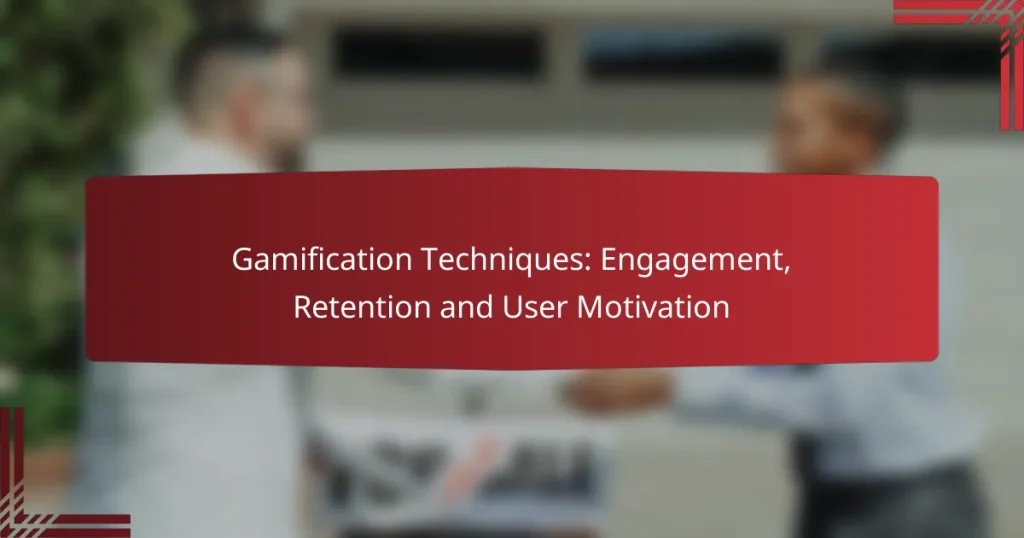Gamification techniques leverage game-like elements to boost user engagement in non-game contexts, transforming mundane activities into enjoyable experiences. By incorporating strategies such as reward systems and progress tracking, businesses can enhance user retention and satisfaction, encouraging users to interact more frequently with their products or services. Understanding the intrinsic and extrinsic motivations behind user behavior is crucial for designing effective gamification strategies that foster ongoing participation.

How can gamification techniques enhance user engagement?
Gamification techniques enhance user engagement by incorporating game-like elements into non-game contexts, making activities more enjoyable and motivating. This approach encourages users to interact more frequently and deeply with a product or service, leading to improved retention and satisfaction.
Increased interactivity
Increased interactivity is a core benefit of gamification, as it transforms passive experiences into active participation. Users are more likely to engage when they can influence outcomes through their actions, such as completing tasks or earning rewards. For example, a fitness app that allows users to track their progress and earn badges for milestones fosters a sense of ownership and commitment.
To implement interactivity effectively, consider incorporating elements like quizzes, challenges, or real-time feedback. These features can significantly boost user involvement and make the experience more dynamic.
Personalized experiences
Personalized experiences cater to individual user preferences and behaviors, enhancing engagement through tailored content. By analyzing user data, platforms can offer customized challenges, rewards, and recommendations that resonate with each user. For instance, an e-learning platform might suggest courses based on a learner’s previous activities and achievements.
To create personalized experiences, utilize user profiles and behavior tracking. This allows you to adjust the difficulty of tasks or suggest relevant content, ensuring users feel valued and understood.
Social competition
Social competition leverages the natural human desire to compare and compete with others, driving engagement through leaderboards and challenges. Users are often motivated to improve their performance when they can see how they stack up against peers. For example, a workplace wellness program might include a step challenge where employees compete for the highest number of steps taken.
When incorporating social competition, ensure that it fosters a positive environment. Avoid overly aggressive competition that could discourage participation; instead, focus on friendly rivalry and collaboration to maintain motivation and engagement.
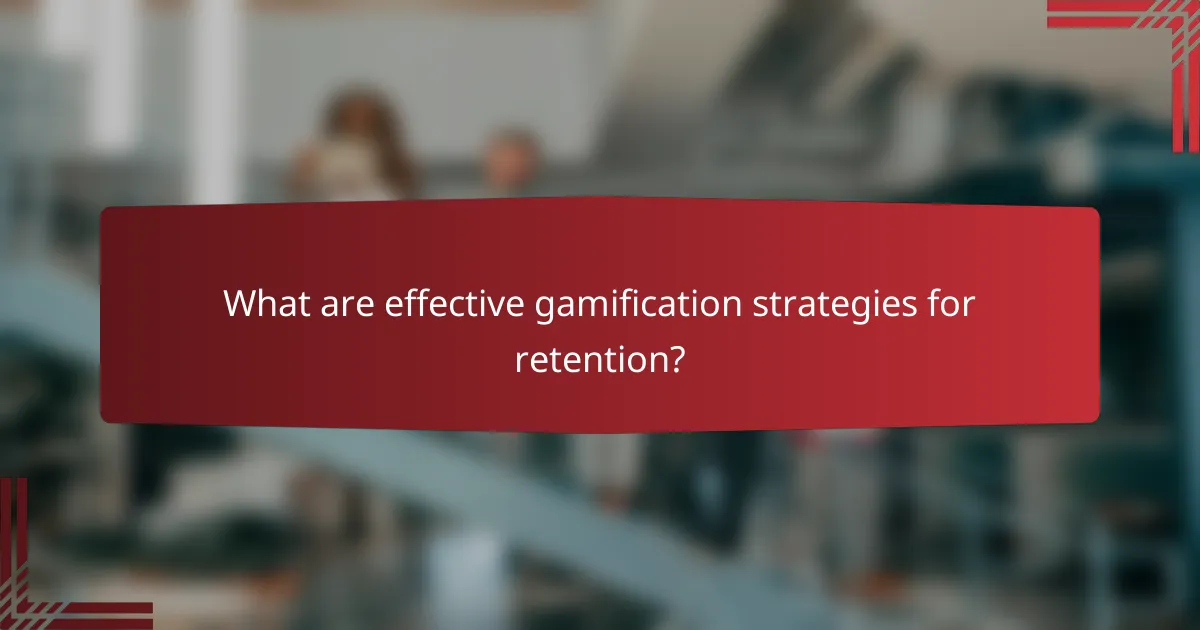
What are effective gamification strategies for retention?
Effective gamification strategies for retention focus on enhancing user engagement through interactive elements that motivate continued participation. By implementing techniques such as reward systems, progress tracking, and feedback loops, businesses can create a more compelling user experience that encourages users to return.
Reward systems
Reward systems are essential for motivating users to engage consistently. These can include points, badges, or levels that users earn through specific actions, creating a sense of achievement. For example, a fitness app might reward users with points for completing workouts, which can be redeemed for discounts on fitness gear.
When designing a reward system, consider the balance between intrinsic and extrinsic motivation. While tangible rewards can drive initial engagement, intrinsic rewards, such as personal satisfaction, can foster long-term retention. Aim for a mix of both to keep users motivated.
Progress tracking
Progress tracking allows users to visualize their journey and accomplishments, which can significantly enhance retention. This can be implemented through dashboards that display completed tasks, milestones achieved, or levels reached. For instance, an educational platform might show users their completed courses and scores, encouraging them to continue learning.
To make progress tracking effective, ensure that it is easily accessible and visually appealing. Use clear indicators like progress bars or checklists to help users see how far they have come and what they need to do next. Regularly updating users on their progress can also maintain their interest and commitment.
Feedback loops
Feedback loops provide users with immediate responses to their actions, reinforcing positive behavior and guiding them toward desired outcomes. This can be achieved through notifications, scores, or performance reviews that inform users about their progress and areas for improvement. For example, a gaming app might provide instant feedback on a player’s performance after each level.
To optimize feedback loops, ensure that the feedback is timely and relevant. Consider using a mix of qualitative and quantitative feedback to cater to different user preferences. Regularly solicit user input to refine the feedback process, ensuring it remains engaging and helpful.
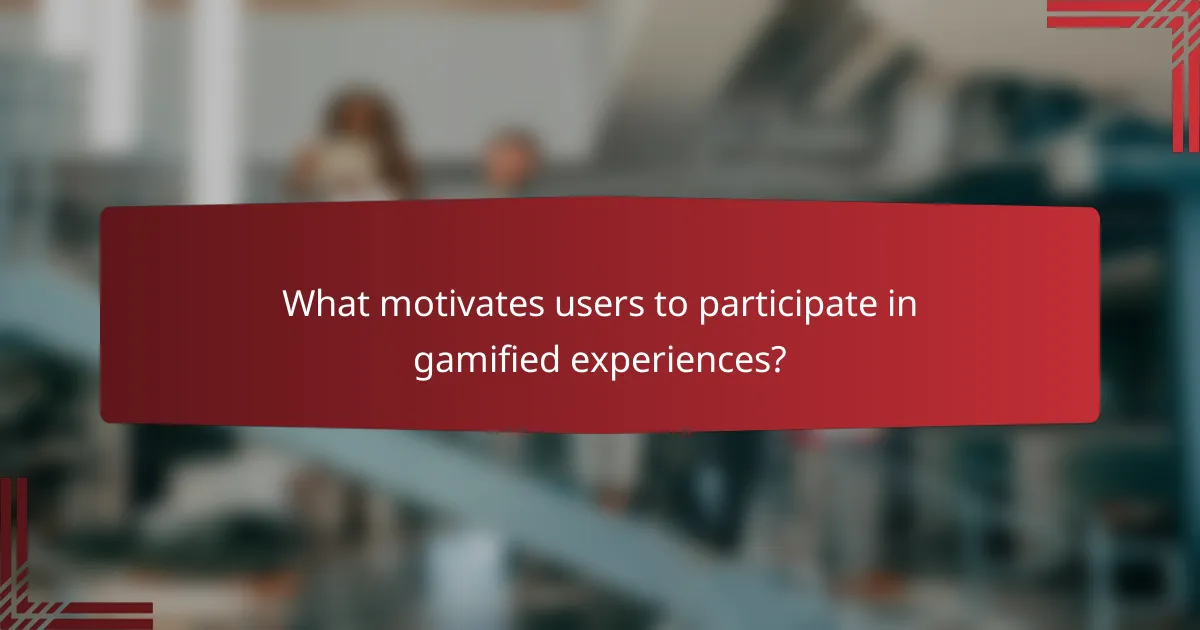
What motivates users to participate in gamified experiences?
Users are motivated to engage in gamified experiences primarily through intrinsic and extrinsic factors, as well as the achievement of goals. Understanding these motivations can help designers create more effective gamification strategies that enhance user engagement and retention.
Intrinsic motivation
Intrinsic motivation refers to the internal drive to participate in an activity for its own sake, often fueled by personal satisfaction or enjoyment. Users who find pleasure in challenges, learning, or self-improvement are more likely to engage deeply with gamified experiences.
To leverage intrinsic motivation, incorporate elements that promote curiosity and mastery. For example, providing users with opportunities to explore new skills or solve complex problems can enhance their enjoyment and commitment to the activity.
Extrinsic rewards
Extrinsic rewards are external incentives, such as points, badges, or monetary prizes, that encourage participation in gamified experiences. These rewards can effectively boost user engagement, especially when they are perceived as valuable and attainable.
However, relying solely on extrinsic rewards can lead to short-term engagement. It’s essential to balance these incentives with intrinsic motivators to foster long-term commitment. For instance, a loyalty program that offers discounts alongside skill-building challenges can maintain user interest over time.
Goal achievement
Goal achievement is a significant motivator in gamified experiences, as users are driven by the desire to reach specific milestones or objectives. Clearly defined goals provide direction and a sense of purpose, making the experience more engaging.
To effectively implement goal achievement, set realistic and attainable objectives that encourage progress. Use progress tracking features to visualize accomplishments, and consider incorporating tiered goals that allow users to experience success at various levels, keeping them motivated throughout their journey.
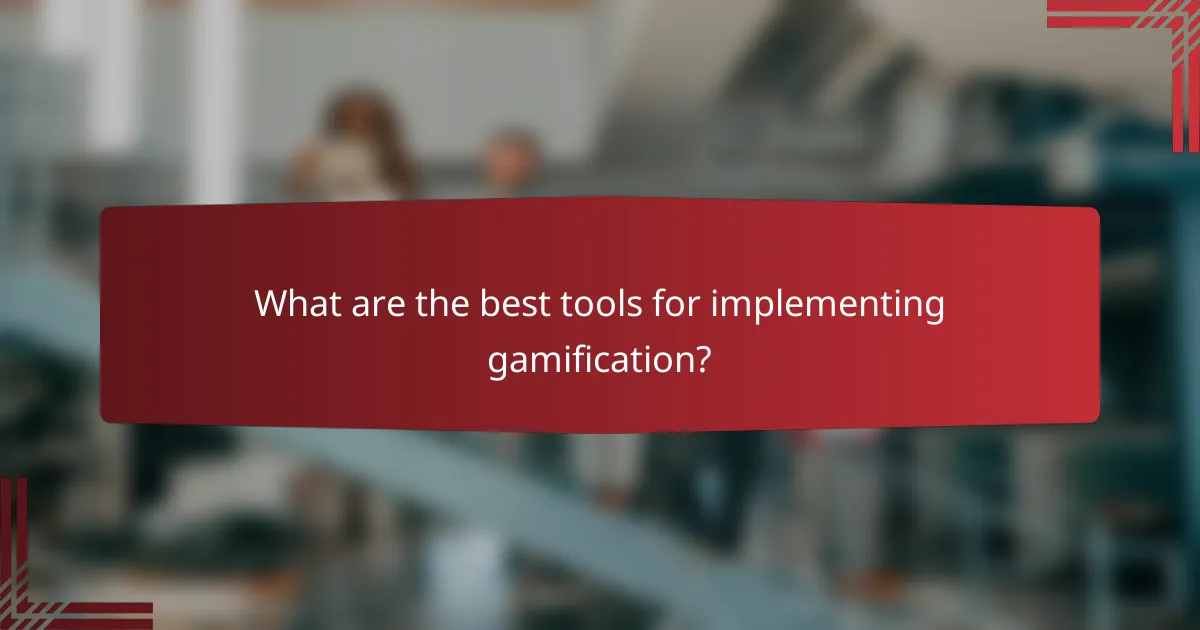
What are the best tools for implementing gamification?
Effective gamification tools enhance user engagement, retention, and motivation by incorporating game-like elements into non-game contexts. The best tools provide features such as rewards systems, progress tracking, and social interaction to foster a dynamic user experience.
Gamify (platform)
Gamify is a versatile platform that allows businesses to create customized gamified experiences tailored to their audience. It offers a range of features including points, badges, and leaderboards, which can be integrated into various applications to boost user interaction.
When using Gamify, consider its ease of integration with existing systems and the flexibility it offers in designing game mechanics. This platform is particularly beneficial for companies looking to enhance training programs or customer engagement initiatives.
Badgeville (software)
Badgeville is a software solution focused on behavior management through gamification. It enables organizations to reward users with badges and achievements for completing tasks, thereby motivating them to engage more deeply with the content.
One of Badgeville’s strengths is its analytics capabilities, allowing businesses to track user behavior and adjust strategies accordingly. However, it’s essential to ensure that the rewards align with user motivations to maximize effectiveness.
Funifier (solution)
Funifier is a gamification solution designed to enhance user engagement through customizable game mechanics. It supports various elements such as challenges, rewards, and social sharing, making it suitable for both educational and corporate environments.
When implementing Funifier, focus on creating meaningful challenges that resonate with your audience. This approach can significantly improve user retention and satisfaction, as users feel a sense of accomplishment and recognition for their efforts.
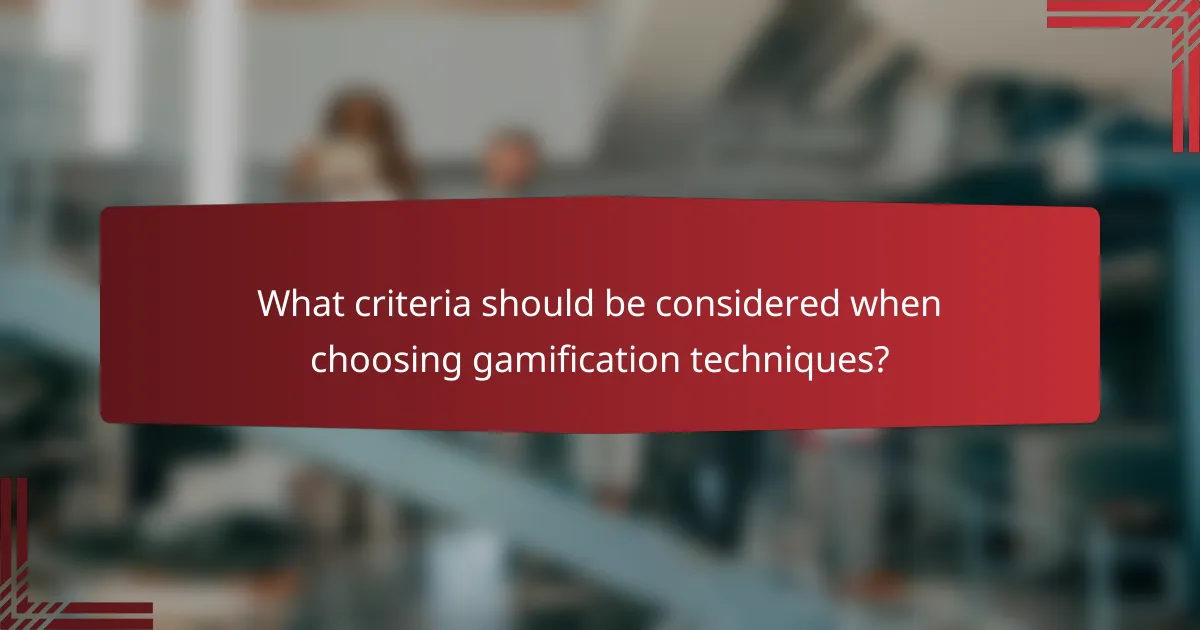
What criteria should be considered when choosing gamification techniques?
When selecting gamification techniques, it’s essential to consider user demographics, business objectives, and industry standards. These criteria ensure that the chosen methods effectively engage users, align with organizational goals, and meet market expectations.
User demographics
User demographics play a crucial role in determining the effectiveness of gamification techniques. Factors such as age, gender, cultural background, and interests can significantly influence how users interact with gamified elements. For instance, younger audiences may respond better to competitive elements, while older users might prefer collaborative features.
To tailor gamification strategies, conduct surveys or analyze user data to understand preferences and behaviors. This insight allows for the creation of personalized experiences that resonate with specific user groups, enhancing engagement and retention.
Business objectives
Aligning gamification techniques with business objectives is vital for achieving desired outcomes. Clearly defined goals, such as increasing user retention, boosting sales, or enhancing customer satisfaction, should guide the selection of gamification elements. For example, if the objective is to improve customer loyalty, incorporating reward systems can incentivize repeat purchases.
Regularly assess the effectiveness of gamified strategies against these objectives. Adjustments may be necessary to ensure that the techniques remain relevant and continue to drive the desired results.
Industry standards
Understanding industry standards is essential when implementing gamification techniques. Different sectors may have specific expectations regarding user engagement and interaction. For example, the gaming industry often emphasizes competition and achievement, while educational platforms may focus on progress tracking and skill development.
Stay informed about best practices and emerging trends within your industry. This knowledge can help in adopting successful gamification strategies that not only meet user expectations but also comply with any relevant regulations or guidelines.
